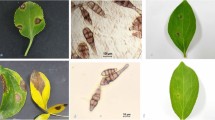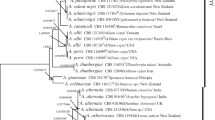Abstract
A new species of Alternaria causing leaf spot of pepper (Capsicum annuum) obtained from the Cameron highlands, Pahang, Malaysia, was determined based on phylogenetic analyses, morphological characteristics, and pathogenicity assays. Phylogenetic analyses of combined dataset of the glyceraldehyde-3-phosphate dehydrogenase (gpd), Alternaria allergen a 1 (Alt a1) and calmodulin genes revealed that the new isolates clustered into a subclade distinct from the closely related Alternaria species A. tomato and A. burnsii. The solitary or short chains of conidia resemble those of A. burnsii. However, conidia with long beaks are morphologically similar to A. tomato. Hence, the pathogenic fungus is proposed as Alternaria capsicicola sp. nov. Pathogenicity assays indicated that A. capsicicola causes leaf spot on pepper.


Similar content being viewed by others
References
Berbee ML, Pirseyedi M, Hubbard S (1999) Cochliobolus phylogenetics and the origin of known, highly virulent pathogens, inferred from ITS and glyceraldehyde-3-phosphate dehydrogenase gene sequences. Mycologia 91:964–977
Bobev S (2009) Reference guide for the diseases of cultivated plants. Unknown journal or publisher
Bremer H (1945) On pod spots in peppers. Phytopathology 35:283–287
Cho WD, Shin HD (2004) List of plant diseases in Korea (4th edn). Korean Society of Plant Pathology, Seoul, Republic of Korea
Chou HH, Wu WS (2002) Phylogenetic analysis of internal transcribed spacer regions of the genus Alternaria, and the significance of filament-beaked conidia. Mycol Res 106:164–169
de Hoog GS, Horre R (2002) Molecular taxonomy of the Alternaria and Ulocladium species from humans and their identification in the routine laboratory. Mycoses 45:259–276
Farr DF, Rossman AY (2014) Fungal databases, systematic mycology and microbiology laboratory. ARS, USDA. Retrieved January 12, from http://nt.ars-grin.gov/fungaldatabases/
Gonzalez-Mendoza D, Argumedo-Delira R, Morales-Trejo A, Pulido-Herrera A, Cervantes-Diaz L, Grimaldo-Juarez O, Alarcon A (2010) A rapid method for isolation of total DNA from pathogenic filamentous plant fungi. Genet Mol Res 9:162–166
Hall TA (1999) BioEdit: a user-friendly biological sequence alignment editor and analysis program for Windows 95/98/NT. Nucleic Acids Symp Ser 41:95–98
Hong SG, Cramer RA, Lawrence CB, Pryor BM (2005) Alt a1 allergen homologs from Alternaria and related taxa: analysis of phylogenetic content and secondary structure. Fungal Genet Biol 42:119–129
Kucharek T (1994) Alternaria diseases of crucifers. Florida Cooperative Extension Service, Fact sheet. University of Florida, Gainesville p 34
Lawrence DP, Park MS, Pryor BM (2012) Nimbya and Embellisia revisited, with nov. comb. for Alternaria celosiae and A. perpunctulata. Mycol Prog 11:799–815
Lawrence DP, Gannibal PB, Peever TL, Pryor BM (2013) The sections of Alternaria: formalizing species-groups concepts. Mycologia 105:530–546
Lawrence DP, Gannibal PB, Dugan FM, Pryor BM (2014) Characterization of Alternaria isolates from the infectoria species-group and a new taxon from Arrhenatherum, Pseudoalternaria arrhenatheria sp. nov. Mycol Prog 13:257–276
Li Y, Zhang D, Xu W, Wu Z, Guo M, Cao A (2011) Alternaria tenuissima causing leaf spot and fruit rot on pepper (Capsicum annuum): first report in China. New Dis Rep 24:3
Mendes MAS, da Silva VL, Dianese JC, Ferreira MASV, Santos CEN, Gomez Neto E, Urben AF, Castro C (1998) Fungos em plants no Brasil. Embrapa-SPI/Embrapa-Cenargen, Brasilia, p 555
Mondal KK, Rana SS, Sood P, Singh Y (2002) Kalazira: a new host for Alternaria burnsii. Indian Phytopathol 55:532
Nees von Esenbeck CG (1816–1817) Das System der Pilze und Schwämme. Stahelsche, Würzburg
Nylander JAA (2004) MrModeltest v2. Program distributed by the author. Evolutionary Biology Centre, Uppsala University, Uppsala
Peever TL, Su G, Carpenter-Boggs L, Timmer LW (2004) Molecular systematics of citrus-associated Alternaria species. Mycologia 96:119–134
Pryor BM, Bigelow DM (2003) Molecular characterization of Embellisia and Nimbya species and their relationship to Alternaria, Ulocladium and Stemphylium. Mycologia 95:1141–1154
Pryor BM, Gilbertson RL (2000) Molecular phylogenetic relationships amongst Alternaria species and related fungi based upon analysis of nuclear ITS and mtSSU rDNA sequences. Mycol Res 104:1312–1321
Pryor BM, Creamer R, Shoemaker RA, McLain-Romero J, Hambleton S (2009) Undifilum, a new genus of endophytic Embellisia oxytropis and Helminthosporium bornmuelleri on legumes. Botany 87:178–194
Rao VG (1969) The genus Alternaria - from India. Nova Hedwigia 17:219–258
Richardson MJ (1990) An annotated list of seed-borne diseases, 4th edn. International Seed Testing Association, Zurich
Ronquist F, Huelsenbeck JP (2003) MRBAYES 3: Bayesian phylogenetic inference under mixed models. Bioinformatics 19:1572–1574
Simmons EG (1992) Alternaria taxonomy: current status, viewpoint, challenge. In: Chelkowski J, Visconti A (eds) Alternaria: biology, plant diseases and metabolites. Elsevier, Amsterdam, pp 9–107
Simmons EG (2007) Alternaria. An identification manual. CBS Biodivers Ser 6:1–775
Simmons EG, Roberts RG (1993) Alternaria themes and variations (73). Mycotaxon 48:109–140
Swofford DL (2002) PAUP*: phylogenetic analysis using parsimony (* and other methods), version 4.0b 10. Sinauer, Sunderland
Tai FL (1979) Sylloge fungorum sinicorum. Science Press, Peking
Thompson JD, Higgins DG, Gibson TJ (1994) Clustal W: improving the sensitivity of progressive multiple sequence alignment through sequence weighting, position-specific gap penalties and weight matrix choice. Nucleic Acids Res 22:4673–4680
Uppal BN, Patel MK, Kamat MN (1938) Alternaria blight of cumin. Indian J Agric Sci 8:49–62
Woudenberg JHC, Groenewald JZ, Binder M, Crous PW (2013) Alternaria redefined. Stud Mycol 75:171–212
Yu SH (2001) Korean species of Alternaria and Stemphylium. National Institute of Agricultural Science and Technology, Suwon
Zhang TY (2003) Flora Fungorum Sinicorum. Vol. 16. Alternaria. Science Press, Beijing
Zhuang WY (ed) (2005) Fungi of northwestern China. Mycotaxon, Ithaca
Acknowledgments
We are grateful to the Malaysian Agricultural Research and Development Institute (MARDI) for collaboration in this study. We acknowledge laboratory assistants and coworkers in plant protection department of University Putra Malaysia (UPM) for valuable field trip arrangements and assistance during field samplings.
Author information
Authors and Affiliations
Corresponding authors
Rights and permissions
About this article
Cite this article
Nasehi, A., Kadir, J.B., Abed Ashtiani, F. et al. Alternaria capsicicola sp. nov., a new species causing leaf spot of pepper (Capsicum annuum) in Malaysia. Mycol Progress 13, 991 (2014). https://doi.org/10.1007/s11557-014-0991-1
Received:
Revised:
Accepted:
Published:
DOI: https://doi.org/10.1007/s11557-014-0991-1




